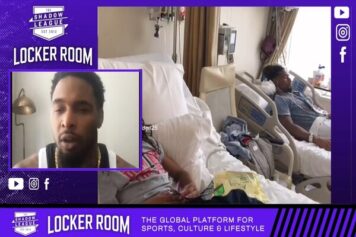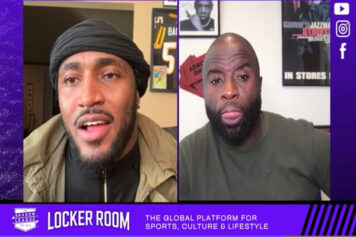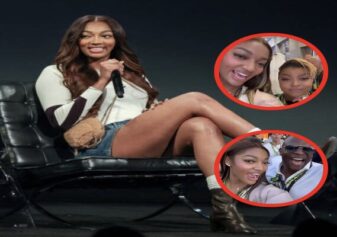Award-winning film Middle of Nowhere tells the story of Ruby, a medical student in Los Angeles. Her husband has been jailed on a multi-year bid, giving Ruby the absurd task of figuring out what their young marriage now means. A lovely, cobalt-colored fugue, Middle of Nowhere shines a light "on the sisters' side of the prison-industrial complex," says its maker, Ava DuVernay. "Women who are waiting and left behind."
"The women who are waiting and left behind" might also describe black ones who make movies, except that DuVernay, 40, will have none of it. As founder of The DuVernay Agency (lka DVA Media + Marketing) in 1999, she brainstormed p.r. strategy for films by Clint Eastwood, Michael Mann, Robert Rodriguez, and others.
What she really wanted to do, though, was direct. A cluster of works soon followed, including hip-hop docs This Is The Life and My Mic Sounds Nice. These led to I Will Follow, her critically-hailed first feature, in 2011.
But, that year, DuVernay also launched what is, arguably, her most audacious piece: the African-American Film Festival Releasing Movement, or AFFRM. It's a 'collaborative,' she explains, of like-minded entities around the country that distribute Black work. Its grass-roots support for Follow, Nowhere, and other directors' movies may be tapping a renaissance, and giving film's old boys' network a wholly new cast.
The Shadow League: You're the first African-American woman to win the Best Director Prize at the Sundance Film Festival. What is the significance of this?
Ava DuVernay: Well, I'm the first African-American woman to win the prize, but I certainly wasn't the first to deserve it. There've been a number of really incredible sisters that have been to Sundance and, for whatever reason, I guess, it wasn't "the right time"…a-ha-ha. So, I definitely acknowledge Julie Dash, and Gina Prince-Bythewood, and Leslie Harris, and Dee Rees, and Tanya Hamilton, and all the amazing women who were there before me.
I think beyond the prize itself, we've gotten elevated attention to this film, and it's something that we most definitely need because we're independent from production to distribution.
But beyond that, it's just a lovely personal thing, and I think to give it any more significance than it is would be a mistake on my part.
How does AFFRM work?
It's a collaborative of non-profits, from film festivals to film series, from Black film schools—Howard University is one of our partners—to Black museums—Houston African-American Museum is one of our partners—and all of these organizations that really corral and cultivate Black art in their individual regions.
We come together and we strategize for six months before the project hits the theaters, and we think of all kinds of out-of-the-box ways to get the word out, and to make sure that the film is distributed properly. So, it goes way beyond promotion. It's the actual distribution of the film, the DCP delivery to the film. Making sure the print is there. Making sure the posters are up. Making sure that we're working in concert with the theater managers. Making sure that we're working on advanced sales. Making sure that, when our cast and filmmakers come into the market, they have a full press schedule.
One of our partners, ImageNation, crafted a Middle of Nowhere art exhibit in their loft space in Harlem, where local artists were invited to make art based on the themes and the narrative of Middle of Nowhere. That opened two weeks before the film opened.
Yes, I saw that. It's around the corner from my home.
Yeah, it's beautiful! So, that's just one of the many kinds of localized ideas that were birthed and executed out of AFFRM, and that's something that allows us to go beyond what a standard studio would do in promotion of the film.
The leading art film house, here, in New York City, is called the Angelika. Maybe you've heard of it.
Uh, yes, I have heard of it.
Why isn't your film screening there?
You'd have to ask them. We offered it to them.
And what did they say?
Um, "No." (laughs) Yup.
They said, "No"?
Yeah! I mean, the film was offered to and pitched to every major art house in the country. Where it's not playing is the choice of the venue. So, whether it's not returning calls, not engaging in a meaningful way, or just straight up, "No," all of those equate to the film not playing there. So, we focus on where we can play. And we make sure that the film is in every major market so that folks that were interested in it could see it. It may not be where they're used to seeing art house films, but it was available. Each and every theater is a fight; but we're in, and we're playing, and we can only stay as long as people come and patronize the film.
What do you make of the response art houses have had to Middle of Nowhere?
You know, it's challenging for me because, at this very moment, my mind is so focused on giving the film its best life, and working in places where I can exhibit the film. So, this might not be the best kind of timing for me to step back and analyze the historical nature of this kind of shutout of Black independent films from art houses and American independent venues.
But, yeah, it sucks! It's arrogant, it's ignorance, it's unacceptable. One way you accept it is by going away with your tale between your legs. One way that you don't accept it, is you book at the chain across the street, and you open No.1 independent box office. So we decided to keep going, and keep working, and we're happy that we did. Our partners who did exhibit with us were rewarded with a really nice opening weekend, and those that didn't, didn't.
You've said that fewer than 10 percent of the films Hollywood releases are contemporary dramatic representations of Black people, and the ones that tend to get made are historical dramas — in your words, "everything in hindsight." Why is this the case?
(let's out a brief, almost startled laugh) I'm so sorry! I'm getting asked these really amazing questions, but I resist… I…I…
My favorite thing to do is not to talk about everything that's wrong. We know it already. I'm really in the space of trying to move things forward and make them right in a new way; to not continue to try and knock on these doors that have been historically and "ongoing–ly" — not a word, but you know what I'm saying — shut to us, or hard to get through, or "one-at-a-timed."
(Starting to laugh again) Why is it the case that they only like to see us in hindsight? I mean, I'm sure we can all put together the dots on why that would be: that they get something much more dangerous in looking at African-Americans in the here and now. I say "African-Americans" in contrast to even African drama. You put an African drama in the art house and it will be booked, and it will have ticket sales, because it's seen as something acceptable, perhaps.
But just to look at Black folk, right here, in 2012, in America — there's been ongoing resistance to it. It's much more comfortable looking at us in the past, or looking at us through a comedic lens.
I had a number of realizations, watching this film. One occurred during the scene where Ruby gets roses, and this lovely piece of music is played in the background. It made me aware of how rare it is for black music to be used to set a serious, or contemplative, mood in a Hollywood film.
Someone had said that it's radical to just see black people sitting quietly, thinking about what they're gonna do next: The image of black folk thinking, black folk being meditative, black folk being quiet. It's really a hallmark of European cinema, and what we see a lot in the American independent cinema space. But with our black cinematic images, we're always on the move, laughing…or in hindsight.
I think that what you're seeing now, from black independent filmmakers, is something that's a little more nuanced, and a little more…spatial. And so, with that, you have a lot of beautiful room to play with other independent artists on the music side of things.
How did being a marketer for films like those by Steven Spielberg and others prepare you to make this film?
It was a demystification of what it took and who could make movies. Standing on these sets and observing these folks make their films, and direct their actors, and collaborate with their DPs, and oversee their production design; then also being in the room within the marketing meetings, and overseeing aspects of these big studio campaigns just demystified the process of moviemaking. Something that I had once seen as magic, that was unobtainable to me, now I see as magic that I can make, too.



